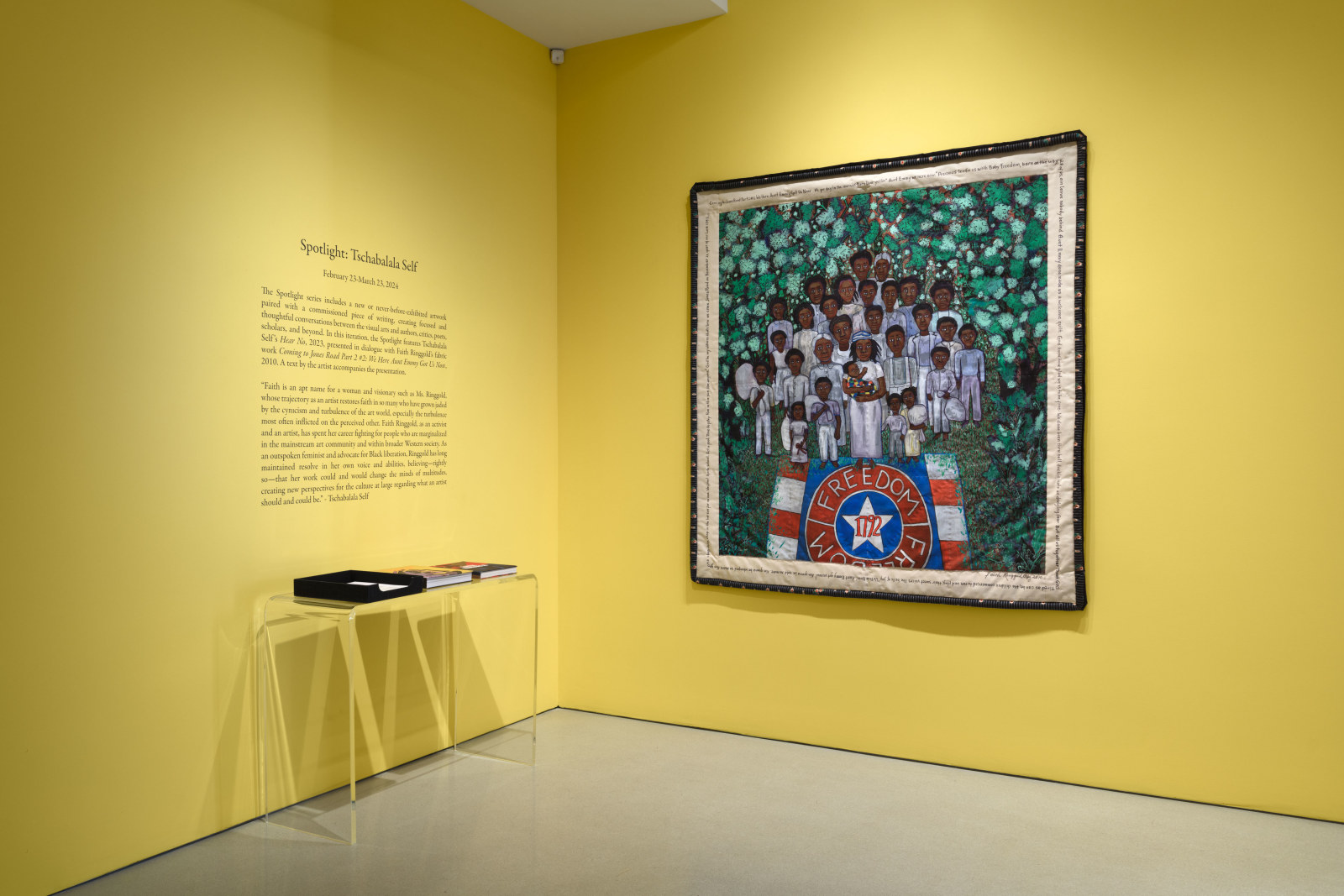Overview
On ‘Hear No’, 2023
By Tschabalala Self Studio
Hear No, 2023 delves into the world of a Black feminine figure suspended in motion. Her leg is mid-stride, almost as if to walk across the canvas. Her left arm lifts up and across her body, palm to the viewer and the back of her hand up against her ear. Her cheeks blush and eyes focus forward, but what she looks upon is unknown. The body of the figure is engulfed by a pastel green and yellow pattern, a repeated abstraction, that can be vaguely interpreted as an open eye, or parted mouth. Viewers are left to question what context there is, if any, for the character as she traverses the liminal space beyond her body.
The figure is untethered to space, giving her presence a mysterious and ethereal flare. Her environment has no bounds; the space she occupies is never-ending and ceases to reveal much concrete detail. Does she exist in a material or emotional state? The only clue about the painting’s protagonist can be derived from its title, Hear No. This shorthand abbreviation references the Buddhist proverb, "see no evil, hear no evil, speak no evil." The principle is a linguistic embodiment of the three wise monkeys from the Japanese pictorial maxim. Traditionally, the monkey Mizaru represents “see no evil,” and is often portrayed covering his eyes; Kikazaru, who hears no evil, is shown covering his ears; and Iwazaru, who speaks no evil, covers his mouth. The most applicable meaning ascribed to the saying encompasses the practice of being of good mind, speech, and action. The tenets of the proverb adhere to the habit of not dwelling on negative or evil thoughts and actions. Originating in the second century BCE and popularized in the seventeenth century, the proverb still finds itself circulating through contemporary pop-culture.
Tschabalala Self pulls from various influences in Hear No, including her reference to the West African practice of Batik creation. Batik is one of the oldest art practices to date, tracing as far back as the wrapping of Egyptian mummies. Batik is an intuitive textile dyeing method, similar to tie-dying but far more complex in its nature. During the process, hot wax is applied to the fabric with a stamp, prior to dye application, then removed via boiling after the dye has settled. This leaves a negative space with one's desired pattern in place of the wax. The origins of Batik are blurry–most narratives point to Indonesia as one possible origin and main point of development—the process is said to have arrived and been popularized in West Africa through Dutch and English colonization. Equipped with their wax batiks and fabrics, they targeted a local population already positioned for their consumption.
This practice, while not identical, relates to Self’s printing process and use of stamps. Often, she carves patterns into wood blocks or makes large silicone molds that function as stamps. These matrices are used to print onto her canvases creating bold shapes and designs. The process is messy and tedious but yields results worth the effort. Beyond printmaking, the artist’s relationship to textiles runs deep; one could say it’s generational. Her studio is brimming with fabric scraps found, bought, recycled, and some inherited, passed down from her mother, an avid textile collector. An entire back room in the studio is dedicated to storing her adorned collection of textiles. From this room, bins of this fabric are rolled to and from the sewing machine, where she fabricates intricate patchworks tapestries. After piecing together the textile fragments, Self configures a character’s body, limb by limb, spending hours—sometimes days—slowly fashioning her subjects, crafting unique assemblages. Each facet of her characters is composed and then finally, one by one, sewn to the canvas. Everything, down to the last fingernail, is individually shaped, placed, and sewn into the design. Once the figure is set, the canvas is then stretched, painted, and finally applied to the canvas plane.
The emotional, physical, and psychological implications of the figure’s fashioning gives way to the existential concerns they possess. Self believes all individuals are a sum of many parts, and the formal nature of her practice precisely articulates this fundamental idea. In Hear No, there exists a tension between foreground and background that mirrors the character’s position in the larger social context. The silhouette emerges and disintegrates into the pictorial plane; there is a tension between her body and her world—there is conflict, there is fragility, there is fear, there is freedom, there is an unresolved desire for her own forward projection.
Self’s figures are meant to live free from other’s assertions and the othering gaze of a presumed viewer. One can assume that the subject in Hear No is fully aware of their conspicuousness and is unmoved by this fact. The character’s role is not to show, explain, or perform but rather “to be.” In being, their presence is acknowledged, and their significance is felt. One is left with very little information lending to the personal life of the character and that is Self’s intention. We know not of where she is going, but simply that she is determined to stay on course.
The FLAG Art Foundation, New York
545 West 25th Street, 9th Floor, New York, NY 10001




